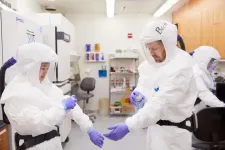Vegetation of planet Earth: Researchers publish unique database as Open Access
2021-06-21
(Press-News.org) It's a treasure trove of data: the global geodatabase of vegetation plots "sPlotOpen" is now freely accessible. It contains data on vegetation from 114 countries and from all climate zones on Earth. The database was compiled by an international team of researchers led by Martin Luther University Halle-Wittenberg (MLU), the German Centre for Integrative Biodiversity Research (iDiv) and the French National Centre for Scientific Research (CNRS). Researchers around the world finally have a balanced, representative dataset of the Earth's vegetation at their disposal, as the team reports in the journal Global Ecology & Biogeography.
Global issues and questions require global answers. "If we want to understand or predict how climate change will affect biodiversity in all regions on Earth, we have to consider them in their entirety. We need more than just data from a few well-studied regions," explains Professor Helge Bruelheide, a geobotanist at MLU and a member of iDiv. Instead, a global geodatabase is required with information on vegetation from all continents and climate zones.
Now, with the launch of "sPlotOpen", this database not only exists but it can be accessed by anyone who is interested. Around 100,000 vegetation plots from 114 countries have been entered into the database which has been release as open access. Each data point contains information on all of the plant species co-occurring at that location, alongside geographical, temporal and methodological metadata. This enables researchers to see exactly when, where and by whom the data point was collected.
Most importantly, sPlotOpen provides information about the complete plant community that can be found at the respective location. This is one of the great advantages of the new database, explains Dr Francesco Maria Sabatini from MLU and iDiv, who is coordinating the project together with Dr Jonathan Lenoir from the CNRS. "There are already several databases that show the distribution of individual plant species worldwide. In reality, however, plant species rarely occur alone and in isolation," says the researcher. With the aid of "sPlotOpen", scientists could figure out whether the data was collected from a forest - with various tree and grass species - or a meadow. According to the biologist, this is important when selecting individual surveys for specific research projects that are meant to investigate, for instance, only forests or grasslands.
Another advantage is that the team has attempted to balance the data. "There is already an incredible wealth of data on vegetation in Europe, North America and Australia. But, for many different reasons, there is much less data on other regions," says Sabatini. If the data from all countries were compared without weighting it first, false conclusions could be drawn. Therefore, the team tried to establish a certain comparability between the datasets from different regions. For example, not all data from Western Europe was included in the project - only a representative selection. The team already balanced the data for the benefit of future users. This should prevent a striking imbalance of data over regions that are less well documented, for example, warm or cold, dry or humid climates. "Our database has the potential to be a gamechanger for research projects in the field of macroecology and beyond," explains Sabatini. It could also be used in the field of geoscience, for example, to train algorithms for analysing satellite images. If you know where a certain community of plants exists, you can associate this plant community to a specific pattern in satellite images, namely a specific spectral community, and search other images for the same patterns.
In order to create this unique set of data, the team from Germany and France have relied on the support of 161 researchers from 57 countries who participated in the project by providing data. "Behind these individual datasets are countless colleagues and students, who went to the field collecting data in the first place. The sPlotOpen database could not exist without them" says Sabatini. The data also comes from national projects, such as the German Vegetation Reference Database, which is managed at MLU by Helge Bruelheide's research group.
INFORMATION:
About the study: Sabatini F.M., Lenoir J., et al. sPlotOpen - An environmentally-balanced, open-access, global dataset of vegetation plots. Global Ecology and Biogeography (2021). Doi: 10.1111/geb.13346
https://onlinelibrary.wiley.com/doi/full/10.1111/geb.13346
ELSE PRESS RELEASES FROM THIS DATE:
2021-06-21
June 21, 2021 -- A new study published in Nutrients investigated the effect of increased dietary potassium from a whole food source--baked/boiled potatoes and baked French fries--or a potassium supplement on blood pressure and other cardiovascular disease risk factors compared to a 'typical American' control diet (lower potassium intake) among 30 pre-hypertensive to hypertensive men and women. Results showed that including baked/boiled potato consumption as part of a typical American diet had the greatest benefit on reducing sodium retention, even more than the supplement, and resulted ...
2021-06-21
COVID-19 therapies made from antibodies often are given to patients who are at high risk of severe illness and hospitalization. However, there have been nagging questions about whether such antibody therapies retain their effectiveness as worrisome new virus variants arise.
New research at Washington University School of Medicine in St. Louis suggests that many, but not all, therapies made from combinations of two antibodies are effective against a wide range of variants of the virus. Further, combination therapies appear to prevent the emergence of drug resistance.
The study, in mice and hamsters, tested all single and combination antibody-based therapies authorized for emergency use ...
2021-06-21
HOUSTON - (June 21, 2021) - Diamond may be just a phase carbon goes through when exposed to a flash of heat, but that makes it far easier to obtain.
The Rice University lab of chemist James Tour is now able to "evolve" carbon through phases that include valuable nanodiamond by tightly controlling the flash Joule heating process they developed 18 months ago.
Best of all, they can stop the process at will to get product they want.
In the American Chemical Society journal ACS Nano, the researchers led by Tour and graduate student and lead author Weiyin Chen show that adding organic fluorine compounds and ...
2021-06-21
LAWRENCE -- Tulsa may not be the first town one thinks of when talking about jazz, and flood management may not be the first vocation one compares to the musical genre. But the success Tulsa displayed in going from one of the nation's most flood-prone cities to a nationally recognized model of long-term risk reduction in just two decades is analogous to the evolution of one of the most American styles of music, a University of Kansas professor points out in a new study.
Tulsa, the second-largest city in Oklahoma, suffered several devastating floods in the 1970s and 1980s, then became a national model for flood mitigation by the 1990s. What hasn't been studied closely is how a group of engineers, planners, government officials, journalists, attorneys and citizens came together ...
2021-06-21
The word "tsunami" brings immediately to mind the havoc that can be wrought by these uniquely powerful waves. The tsunamis we hear about most often are caused by undersea earthquakes, and the waves they generate can travel at speeds of up to 250 miles per hour and reach tens of meters high when they make landfall and break. They can cause massive flooding and rapid widespread devastation in coastal areas, as happened in Southeast Asia in 2004 and in Japan in 2011.
But significant tsunamis can be caused by other events as well. The partial collapse of the volcano Anak Krakatau in Indonesia in 2018 caused a tsunami that killed more than 400 people. Large landslides, which send immense amounts of debris into the sea, also ...
2021-06-21
Following fertilization, early plant embryos arise through a rapid initial diversification of their component cell types. As a result, this series of coordinated cell divisions rapidly sculpts the embryo's body plan. The developmental phenomenon in question is orchestrated by a transcriptional activation of the plant genome. However, the underlying cellular differentiation programs have long remained obscured as the plant embryos were hard to isolate. In fact, previous attempts at creating datasets of the plant embryonic differentiation programs were incapable ...
2021-06-21
A commonly studied perovskite can superfluoresce at temperatures that are practical to achieve and at timescales long enough to make it potentially useful in quantum computing applications. The finding from North Carolina State University researchers also indicates that superfluorescence may be a common characteristic for this entire class of materials.
Superfluorescence is an example of quantum phase transition - when individual atoms within a material all move through the same phases in tandem, becoming a synchronized unit.
For example, when atoms in an optical material such as a perovskite are excited they can individually radiate light, create energy, and fluoresce. Each atom will start moving through these phases randomly, but given the right conditions, they can synchronize in ...
2021-06-21
All plant cells obtain their energy mainly from two organelles they contain - chloroplasts (responsible for photosynthesis) and mitochondria (responsible for the biochemical cycle of respiration that converts sugars into energy). However, a large number of a plant cell's genes in its mitochondria and chloroplasts can develop defects, jeopardising their function. Nevertheless, plant cells evolved an amazing tool called the RNA editosome (a large protein complex) to repair these kinds of errors. It can modify defective messenger RNA that result from defective DNA by transforming (deamination) of certain mRNA nucleotides.
Automatic error correction in plant cells
Automatic error correction in plants was discovered about 30 years ago by a team headed by plant physiologist Axel Brennicke ...
2021-06-21
While the LGBTQ+ community has seen significant advancements in legal rights, political representation and social acceptance over recent years, mental and physical health disparities still exist for queer Americans - and are even worse among younger generations, says a new study from Michigan State University.
In the first-ever population-based national study comparing mental and physical health of lesbian, gay and bisexual (LGB) Americans to their straight counterparts, MSU sociologist Hui Liu and research partner Rin Reczek, professor of sociology from Ohio State University, found that when compared to their straight counterparts, LGB Millennials have worse health disadvantages than their older peers, though disparities persist throughout older generations as ...
2021-06-21
All coronaviruses produce four primary structural proteins and multiple nonstructural proteins. However, the majority of antibody-based SARS-CoV-2 research has focused on the spike and nucleocapsid proteins. A study published in PLOS Biology by Anna Heffron, Irene Ong and colleagues at the University of Wisconsin-Madison, USA, suggests that immune responses may develop against other proteins produced by the SARS-CoV-2 virus.
The efficacy of spike protein-based vaccines is variable and not everyone infected with SARS-CoV-2 produces detectable antibodies against the spike or ...
LAST 30 PRESS RELEASES:
[Press-News.org] Vegetation of planet Earth: Researchers publish unique database as Open Access


